#camoufleur
Text

» Vermilion Sands «
Christine Moldrickx
Elger Esser
Swen Buckner
Tobias Hantmann
Vernissage
Samstag, 16. September 2023, 18 Uhr
Ausstellungsdauer 16.09.-14.10.2023
Galerie Camoufleur
35, rue Aristote
59800 Lille (FR)
https://www.instagram.com/studio.camoufleur/
0 notes
Text
Simulating Natural Lighting the 1940s Way
How do you figure out whether the camouflage scheme you're planning for a cooling tower is going to work? Well, the Second World War camofleurs (a shorter term than "camouflage officers") had a tool, as recorded in Josh Cole's article regarding concealing infrastructure on the site dedicated to Colin Moss, a Suffolk-born painter, draughtsman - and camofleur.
The more complex concealment schemes were tested on scale models in the Rink in Leamington Spa.
As Colin explained … “You worked on a scale model and … there was a turn-table which you could put it on and a moving light, which represented the sun, and you got up on a platform, which was about the height that a bombing pilot would come in at, and turn the thing around to see how it reacted to different times of day.”
Journalist Virginia Ironside (daughter of camoufleur Christopher Ironside) memorably described the Rink as “a giant studio” where “artists slaved away over enormous turntables on which they had constructed models of factories and aerodromes, lit by ever moving moons and suns attached to wires”.
To me, this is a delightfully analogue solution.
2 notes
·
View notes
Audio
2 notes
·
View notes
Video
youtube
Gastr Del Sol | Black Horse
6 notes
·
View notes
Video
youtube
Song of the Day
Gastr Del Sol - Each Dream is an Example (Camoufleur)
2 notes
·
View notes
Text
Camoufleur, Gastr del Sol (1998)

Gastr del Sol’s final album saw folk pirouette through the void, whimsical indie twisting amongst interstellar drones, blared jazz and intricate experimentalism – a fitting send off for a perplexing band.
Pick: ‘Seasons Reversed’
#Post-Rock#Experimental Rock#Chamber Folk#American Primitivism#Progressive Folk#Art Pop#gastr del sol#camoufleur#folk#rock#pop#music#review#music review#1998
1 note
·
View note
Text
#421 - Camoufleur - Gastr Del Sol

Feels like a predecessor in some ways to O’Rourke’s singer-songwriter work lyrically, though he still keeps with sonic experimentation on this project. A small but delightful charm.
72/100
0 notes
Photo

Lucien-Victor Guirand de Scévola (1871-1950) - Jeune fille de face
Pastel on paper. Executed in 1899.
15 x 18.25 inches, 38 x 46.5 cm. Estimate: £18,000-25,000.
Sold Sotheby’s, London, 12 Nov 2008 for £23,750 incl B.P.
Guirand de Scévola is remembered for his pioneering leadership of Les Camoufleurs (the French Camouflage Department) in World War I.
#Lucien-Victor Guirand de Scévola#Lucien Victor Guirand de Scévola#Lucien-Victor Guirand de Scevola#Lucien Victor Guirand de Scevola#Les Camoufleurs#Camoufleurs
158 notes
·
View notes
Text
142. Nadim Abbas
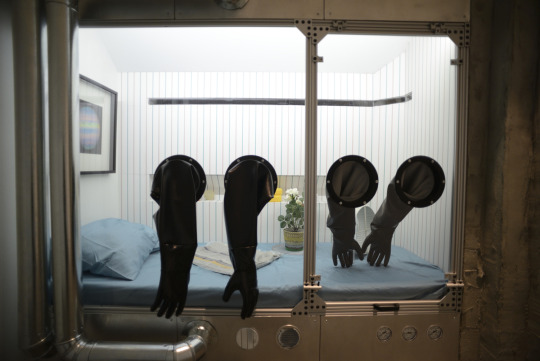
Nadim Abbas, Chamber 664 "Kubrick”, 2014-2015. Mixed media. Dimensions variable. Image courtesy of the artist.
Susie Pentelow interviews Hong-Kong based artist Nadim Abbas about his upcoming solo exhibition ‘Camoufleur’ at VITRINE, London. For ‘Camoufleur’, Abbas will produce a new, site-specific installation which will use camouflage to explore how urban living conditions can dictate our relationship with, and in some cases submission to, the spaces we inhabit. The installation will be accompanied by a series of scheduled performances in the space.
You currently have a solo show at Antenna Space in Shanghai, ‘Chimera’. Could you talk a little about this work?
The starting point was the image of the human rhinovirus (serotype 14), AKA the common cold, which I constructed using various kinds of open source molecular and 3D modelling software. The title connotes both phantasmal and biological origins. The elaborate way that I have chosen to present, or project these viral images into the gallery space, using air blowers and beach balls is an attempt to maintain the ambiguous quality of an image which wavers between real and imaginary, fact and fabrication.

Nadim Abbas, Human Rhinovirus 14, 2016. Mixed media installation. Dimensions variable. Image courtesy of the artist and Antenna Space.
The choice of the common cold virus was deliberate - as something familiar to all, to the point of banality, yet appearing at the same time completely alien. Everything else in the show is an extension of this viral metaphor. This is most blatantly played out in the two isolation chambers (with echoes of my piece at the 2015 New Museum Triennial), which contain a series of modular geometric forms that act as a playground for renegade toilet rolls.
The work ‘Blancmange, n ways’ acts as a separate counterpart with similar thematics. Here, white forms become specific manifestations of the first four iterations of the fractal Blancmange function, which derives its name from its resemblance to the famous dessert. In England of course, ‘blancmange’ also connotes a boring or uninteresting person. The photograph on the wall depicts an actual blancmange pudding, as does the pattern design on the wallpaper - setting up a visual pun of sorts.
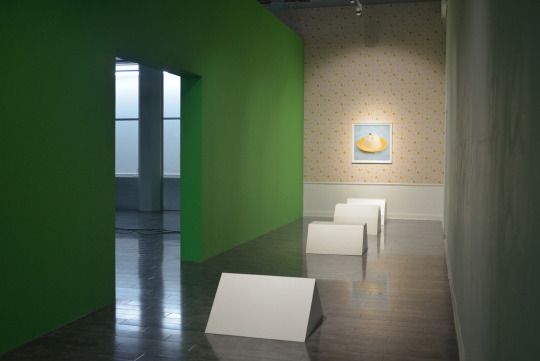
Nadim Abbas, Blancmange, n ways, 2016. Mixed media installation. Dimensions variable. Image courtesy of the artist and Antenna Space.
Works like ‘Chamber 667’ and ‘Chamber 664 "Kubrick”’ could almost be sets from a science fiction film. Is sci-fi an influence?
Regarding the sci-fi influence - the short answer is yes! I am a big science fiction nut. I wrote a short text on this connection (between sci-fi and my work) many years ago. It was around that time that I discovered these molecular renderings of viruses, which were later to become the central motif of 'Chimera'. The text was never published, and I'm not even sure that it makes any sense. Basically, 'Chimera' was my way of materially resolving some of the concerns that were started in writing.
There are many visual parallels between my work and cinema, simply because much of what I do involves the notion of converting (lived) space into an image (memory), which is something that comes almost second nature to the cinematic process. Given the popularity of sci-fi blockbusters today, I should clarify here that I'm less interested in constructing seamless, illusory images like you might see in the latest Star Wars spin-off. Rather, I'm fascinated with finding ways of letting the inconsistencies show through, like in a low budget B-movie. In other words, there is always an element of theatre present in my approach.

Nadim Abbas, The Last Vehicle, 2016. Mixed media installation with durational performance. Dimensions variable. Image courtesy of the artist .
You are working with camouflage for this installation/body of work. How do you think this idea reflects broader themes in society?
A lot of my recent work tries to unravel how certain conditions of urban domesticity have produced specific types of sociability and subcultures. I am also fascinated by what at first glance seems like an unlikely correlation between domesticity and warfare; how technologies developed on the battlefield have found applications in quotidian contexts and vice versa. More chilling perhaps is the notion, suggested by theorists such as Paul Virilio and Beatrice Colomina, that the dream of domestic bliss is but a dormant extension of an ongoing militarised state of emergency, where the household finds its mirror in the bunker/fortress.
It is no coincidence, for instance, that iRobot, a manufacturer of automatic vacuum cleaners, displays on its website products dedicated for the “home” side-by-side with similar technologies repurposed for “defence and security”. Taglines such as “Welcome home. Your house is clean” are made in the same breath as “Placing a safer distance between people and danger”. Since the machinations of modern warfare destroy the very condition of human habitats, military constructions have become increasingly geared towards the possibility of inhabiting such artificial climates (e.g. the underground bunker as a refuge from nuclear fallout). The modern household simply adapts this formula by providing increasingly artificial climates optimised for human habitation (e.g. the fully automated, air-conditioned high-rise service apartment).
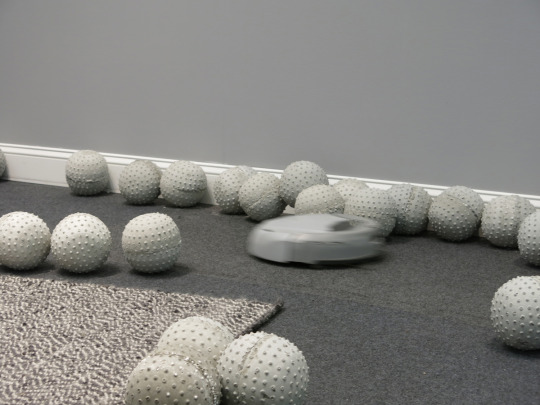
Nadim Abbas, Zone I, 2014. Lightweight concrete casts, robotic vacuum cleaner, rug, skirting board, house paint. Dimensions variable. Image courtesy of the artist.
The title “camoufleur” is borrowed from the name that was given to people who designed and implemented military camouflage during WWI/WWII. Many of these camoufleurs were artists but there were also zoologists and naturalists such as Hugh Cott, whose book, Adaptive Coloration in Animals became a seminal text for the study and development of camouflage techniques in the military. For the setup at VITRINE, I will design a wallpaper pattern that becomes the backdrop and point of reference for everything that is subsequently placed in the space.
For this body of work, your focus is on the figure of the “otaku” or “hikikomori”, terms which originated in Japan. Can you explain these?
Otaku and hikikomori are (Japanese) terms that have come to represent stereotypes of socially ill-equipped, middle-aged males who wall themselves up at home in an escapist world of manga and anime consumption. Otaku generally refers to participants of a subset of cultural practices that revolve around manga and anime fandom. Hikikomori refers to the specific phenomenon of acute social withdrawal. In Chinese, otaku is often translated as “jaaknam” or “zhainan”, which literally means “resident male” (as in resident of a housing complex or tenement block), thus conflating the connotations of otaku and hikikomori. It would take a lot more explanation to unpack the respective nuances of these terms and their ongoing mutations, so I will just focus on the fact that otaku culture arose, or at least thrives, within a uniquely urban, post-industrial context.
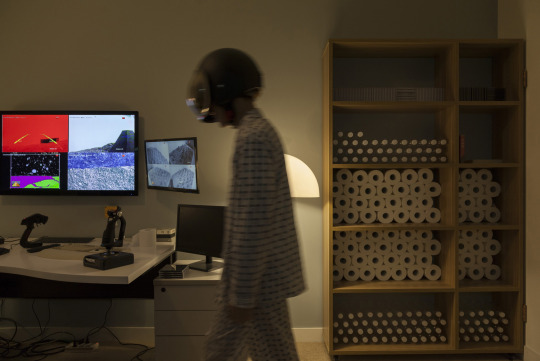
Nadim Abbas, The Last Vehicle, 2016. Mixed media installation with durational performance. Dimensions variable. Image courtesy of the artist.
My concern then is not why otaku do what they do, but rather, what kind of space allows this to happen? It is as if the extremely dense accumulation of cramped interior spaces that characterise so many cities today encourages a turning inward, or a vacuum of mental space itself; a vacuum that disturbs the distinction between the animate and the inanimate, or subject and object. This logic is made visible in the practice of mimicry: picture a masked body, driven to disappear into its surroundings, to be engulfed by objects whose animation increases in proportion to its own lack of animation.
How will you respond to the position of the space on the public sphere?
The unique positioning of the VITRINE space, which stays open and visible at all hours of the day, creates an interesting set of possibilities for the public display of domesticity. The window display, which can more easily facilitate instances of repeated daily viewing, structures an encounter that varies according to the state of each visit. It is this durational quality that pushed me to find different ways of inhabiting the space at different points of the day/week/month. States of habitation that when considered together start to overlap, and become harder to distinguish from one other: a performer who behaves like a machine, or a machine that is performing?

Nadim Abbas, #4, 2016. Cosplay helmet mounted on green screen / cyclorama. Dimensions variable. Image courtesy of the artist and Luke Casey.
There will also be a performance aspect to the exhibition - can you talk about your ideas for this?
The performer will be presented with a set of instructions, or perhaps a distilled script of some sort. We will work together in advance to develop a specific body language. I’m looking for someone with the type of movement training that would facilitate the emptying of gestures, or gestures that do not call attention to themselves, the gesture of stones. If the objective is to perform a disappearing act, it would seem that the magician has already disappeared before the act has begun. Likely candidates might include people who are trained in physical theatre, mime, Butoh; or even life models, who like stick insects are inclined to assume the same pose for extended periods of time.
Interview by Susie Pentelow.
‘Camoufleur’ will run between 1 March and 15 April 2017 at VITRINE, London SE1 3UN, with a preview on Tuesday 28 February 2017, 6.30 – 9 pm. For more information, visit http://www.vitrinegallery.com/exhibitions/camoufleur/.
‘Chimera’ continues until 22 January 2017 at Antenna Space, Shanghai. Visit http://www.antenna-space.com/en/exhibitions/chimera for more information.
Find out more about Nadim Abbas’ work at http://www.nadimabbas.com.
#Nadim Abbas#Chimera#Camoufleur#exhibitions#London#Shanghai#performance#installation#iRobot#technology#Otaku#Hikikomori#cosplay#urban#post-industrial#art#artist#artist interview#traction#subcultures#sci-fi#VITRINE#Antenna Space
1 note
·
View note
Photo
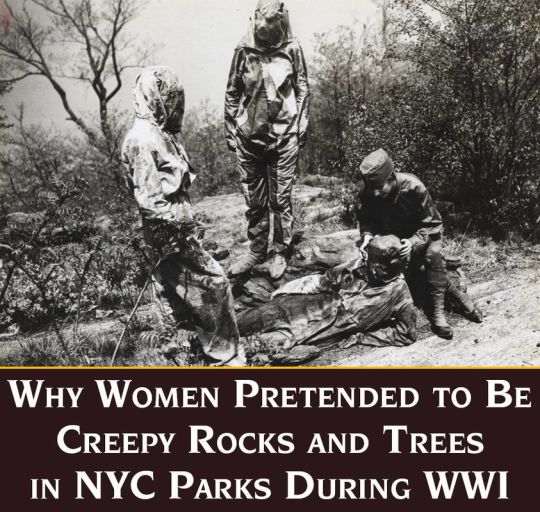
In the midst of World War I, female artists from across the United States flocked to New York City to become part of a highly specialized military group: the Women’s Reserve Camouflage Corps. As part of this little-known division of the National League for Women’s Service, they learned the art of camouflage and then used their artistic skills and creativity to develop patterns and designs that mimicked the landscape -- from the rocks on the ground to the branches of trees. The division had been essentially forgotten, but thanks to a set of photographs discovered during the National Archives and Records Administration’s project to digitize films and photographs from World War I, their work is finally back in view.
And, as National Archives archivist Richard Green explains, they show just how unusual the women's work was: “The photos are really some of the most unusual I’ve come across during my time here. There would be a picture of the girl and she would just fall down and disappear.”The first class of camouflage artists or "camoufleurs" started training in April of 1918; the 40 women were almost all working artists. The division’s director, Lieutenant H. Ledyard Towle of the 71st Infantry, insisted that the women receive the same training in army formations and maneuvers that any soldier would undergo, believing that they could not provide the best protection for soldiers without knowing how they operated.
Twice a week, they would go out into the field -- usually into local parks -- and test out camouflage designs, including “rock suits” that allowed them to be undetected at a distance of 10 feet. They also created “observation suits” that allowed scouts to blend into the sky, snow, or ice while observing enemy movements.An article about the women in the April 28, 1918 issue of the New York Tribune by Elene Foster describes the strange scene when they were working on their designs in the park: "Weird shapes, the color of the rocks and earth, moved here and there, and from the tops of trees came loud halloos and catcalls from other shapeless objects. I stumbled over a hump of grass, which squealed when I stepped on it, and rose before me."
Her article also captures the artists' dedication to their craft and their determination to contribute to the war effort: “Please don’t go away with the idea that all we do is make costumes and dress up in them,” one of the camoufleurs told Foster. “We are going to do every sort of camouflage work that they will allow us to do, from painting a battleship to making a fake tree.”
To view photos of the Women’s Reserve Camouflage Corps on the National Archives' website, visit https://bit.ly/3mJaOly
For an excellent book about 16 remarkable women who served their countries in a variety of ways during World War I, we highly recommend “Women Heroes of World War I" for teens and adults, ages 13 and up, at https://www.amightygirl.com/women-heroes-of-world-war-i
For two picture books about American women serving their country during World War I, we recommend "Grace Banker and Her Hello Girls Answer the Call" (https://www.amightygirl.com/grace-banker-hello-girls) and "Doing Her Bit: A Story About the Woman's Land Army of America" (https://www.amightygirl.com/doing-her-bit), for ages 5 to 9
There is also a lovely new picture book about a Girl Scout running a peach pit drive to help soldiers during WWI: "The Peach Pit Parade: A World War I Story" for ages 5 to 9 at https://www.amightygirl.com/the-peach-pit-parade
For books for adult readers about the contributions of women during WWI, check out "The Hello Girls: America's First Women Soldiers" (https://www.amightygirl.com/the-hello-girls) and "The Second Line of Defense: American Women and World War I" (https://www.amightygirl.com/the-second-line-of-defense)
To learn about more heroic women of WWI, visit our blog post "9 Heroic Women of World War I You Should Know" at https://www.amightygirl.com/blog?p=21319
For many stories for children and teens of pioneering girls and women in the arts -- both in real-life and fiction -- visit our "Creative Arts" section at http://amgrl.co/2ibkDIQ
5 notes
·
View notes
Photo

Joseph Imhof (American, 1871-1955), The Camoufleurs. Oil on board, 30 x 46 in.
202 notes
·
View notes
Photo

La playlist de l'émission de ce jeudi matin sur Radio Campus Bruxelles entre 6h30 et 9h : Pseudo Code "Fight Back (The Angels)" (Slaughter in a Tiny Place/Sub Rosa/1981-2010) Pierre Bastien "Pep" (Pop/Rephlex Records/2005) Maja S. K. Ratkje "Voice" (Voice/rune grammofon/2002) Ignatz "Bright Future" (I Live in a Utopia/Aguirre Records/2015-2022) Gastr Del Sol "The Seasons Reverse" (Camoufleur/Domino-Drag City Records/1998) Andrea Laszlo De Simone "Sogno l'amore" (Uomo Donna/42Records/2017) Diseño Corbusier "Meta metalic" (La Contra Ola – Synth Wave & Post Punk from Spain 1980-86/Les Disques Bongo Joe/1985-2018) Eyeless In Gaza "Speech Rapid Fire" (Photographs as Memories/Cherry Red Records/1981) nits "Red Tape" (7"/CBS Records/1981) Stereolab "Blips, Drips and Strips" (Cobra and Phases Group Play Voltage in the Milky Night/Duophonic/1999) Solah "Que je t'aime" (Ballades/Cheap Satanism Records/2022) Arlt "Des amis" (Turnetable/Objet Disque/2022) Dominique A "Gisor" (Kick Peplum EP/Cinq7/2009) Bark Psychosis "Miss Abuse" (Codename: Dustsucker/Fire Records/2004) Jean-Pierre Mirouze "Sexopolis" (Le Mariage Collectif/BORN BAD RECORDS/1971-2012) Serge Gainsbourg & Jean-Claude Vannier "La horse" (Les Années Psychédéliques: 1966-1971/Le Smoke Disque/1969-2007) Jean-Claude Vannier "Le Ballet des accoucheuses" (Electro-Rapide/Finders Keepers Records/1973-2011) Silver Apples "Confusion" (Contact/Kapp Records/1969) The Music Tapes "The Television Tells Us" (First Imaginary Symphony for Nomad/Merge Records/1999) The Baptist Generals "Clear Creek" (Dog/Munich Records/2000) Joanna Newsom ""En Gallop"" (The Milk-Eyed Mender/Drag City/2004) https://www.instagram.com/p/CeTLGGQt_Sg/?igshid=NGJjMDIxMWI=
2 notes
·
View notes
Photo

Sam Prekop — Sam Prekop.
1999 ; Thrill Jockey.
! acquire the album ★ attach a coffee !
~
[ Album Review | Pitchfork ]
I'm psyched. Y'know why? Okay, okay, if you're gonna drag it out of me, I guess I'll tell you-- I'm moving from Minneapolis to Chicago in less than three weeks. And I'm taking Pitchfork with me. It's strange, really, to think about the dramatic changes that are gonna take place in my life in such a short period of time. I mean, for starters, I've sold my car. What a major shift, going from a reliable little Geo Metro to public transportation. And I can't wait.
The beautiful thing about Chicago is that, unlike Minnesota, people actually talk to each other. In Minneapolis, if you talk to someone in the line at the movie theater, they get all nervous and twitchy. It's also slightly warmer there than it is in Minneapolis (though they get more snow). And best of all, everyone's completely laidback. Now, maybe I'm just glamorizing the place 'cause I'm excited about going there, but I've got proof about the laidback thing.
Take, for instance, Chicago's burgeoning post-rock music scene. Bands like Tortoise, Isotope 217, Gastr del Sol, and Stereolab create nothing but the smoothest, jazziest rock you've ever fallen in love with. And Sam Prekop's first self- titled solo effort's in the same category.
You might recognize Sam from his full- time band, the Sea and Cake, another of the many brilliant post-rock outfits coming out of the Windy City. But as with most musicians who front bands and make solo records on the side, you have to wonder what the difference is between the artist's solo music and the band's music. Well, in this case, the main difference is that Prekop's solo stuff is way more toned- down than most Sea and Cake stuff. Which actually sounds better.
On his first solo outing, Prekop seems to have both accidentally epitomized the Chicago post-rock sound, and added new elements to it. Produced by Gastr del Sol's amazing Jim O'Rourke (who also plays on the record), the album comes off, production-wise, like a softer Camoufleur. Musically, it's warm, relaxing, and almost glowing. You can almost feel the wind coming off Lake Michigan on a warm summer day.
Songs like the head- bobbing, pop groove "The Company," the gentle and sublime "A Cloud to the Back," the melancholy "Don't Bother," and the Stereolab-ish, French funk of the record's closer, "So Shy" blend seamlessly into one another, held together by rich instrumentals like invisible Krazy Glue.
Just as old 1940s Chicago blues 78s capture the feeling of depression- era Chi-town, Sam Prekop's solo record encapsulates the city in the late 1990s. Try listening to this on the Blue Line from Clark/Lake to Wicker Park and see if you're still skeptical.
#rock music#post-rock#sam prekop#jim o'rourke#singer songwriter#1999#thrill jockey#1990s#1990s rock#review#pitchfork#debut album
13 notes
·
View notes
Photo

New painting: “Camoufleur” - Acrylic on Wood (16" x 20") This painting is in my solo show, "The Magician and The Thief", at Hollis Taggart. The show will be up until February 15. HOLLIS TAGGART 521 W 26th Street, 1st floor, New York, NY 10001.
#Kenichi Hoshine#KenichiHoshine#Hollis Taggart#HollisTaggart#TheMagicanAndTheThief#The Magician And The Thief
52 notes
·
View notes
Photo

Diagram of the Twenty-Third Headquarters Special Troops by Fred Fox, who wrote the official history of the Ghost Army and served in the unit
“The 603rd Engineer Camouflage Battalion Special - This was the largest unit in the Ghost Army, with 379 men. These visual deceivers, also known as camoufleurs, used an array of inflatable rubber tanks, trunks, artillery, and jeeps to create deceptive tableaux for enemy aerial reconnaissance or distant observers. The unit had spent the previous two years doing camouflage work and included in its ranks many artists specially recruited for that job.
The Signal Company Special - Formerly the 244th Signal Company, this group of 296 men carried out radio deception, also called “spoof radio.” Operators created phony traffic nets, impersonating radio operators from real units. They mastered the art of mimicking an operator’s method of sending Morse code, to prevent the enemy from realizing that the real unit and its radio operator were long gone.
The 3132 Signal Service Company Special - This sonic deception unit was staffed with 145 men. Their mission was to play sound effects from powerful speakers mounted on half-tracks..., to simulate the sounds of units moving and operating at night. Recently formed, they had been undergoing training at the Army Experimental Station at Pine Camp (now Fort Drum) in upstate New York when the Twenty-Third was assembled and would join them later in England.
The 406th Engineer Combat Company Special - Led by Captain George Rebh, the 168 men of the 406th were trained as fighting soldiers. They provided perimeter security for the rest of the Ghost Army. They also executed construction and demolition tasks, including digging tank and artillery positions. The men of the 406th frequently used their bulldozers to simulate tank tracks as part fo the visual deception.”
- excerpt from “The Ghost Army of World War II by Rick Beyer and Elizabeth Sayles
14 notes
·
View notes
Photo


Exposition Art Blog John Saccaro - Abstract Expressionism Painting
John Saccaro (1913 - 1981).John Saccaro was born in San Francisco, and served as a camoufleur in France in the Army during WWII.He began his artistic career working for the Federal Arts Project in the Murals Section at Treasure Island in the 1930s. In 1939, at the age of 25, he was given a solo show at the San Francisco Museum of Modern Art, and in 1954, he graduated from the California School of Fine Arts
More
#John Saccaro#art#artist#painter#american culture#american artist#American painter#fine art#artistic#painting#oil painting#watercolor#abstract art#abstract painting#abstract expressionism#contemporary art#visual art#culture#blog#art blog#exposition art blog
22 notes
·
View notes